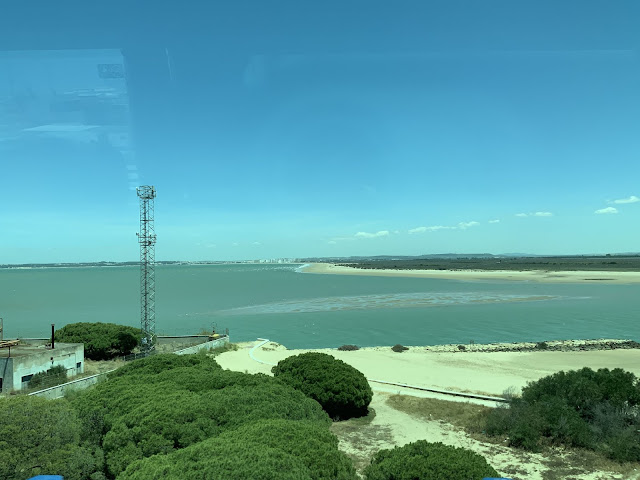June 10,2019, Cadiz / Seville, Spain 150/183 -
Cadiz, population of 125,000, occupies a 5 square mile peninsula on the Atlantic coast. It was inhabited by the Phoenicians about 1100 BC, then by the Romans from 206 BC until the Visigoths overthrew them in 410 AD, then by the Moores (Muslims) from 711 to 1262. Julius Caesar bestowed Roman citizenship on the residents in 49 BC, which entitled them to live tax free. A person could spend months just learning about the complex history of the region.
USA navy, air force, army and marines occupy the largest military base in Spain just across the bay from Cadiz, which is called Rota.
Columbus departed for his exploration trip to the Americas from Cadiz in 1492, establishing it as the main port in Spain for hundreds of years.
Lord Wellington assisted them in their 2.5 year successful defence against Napoleon around 1800. Remember that Wellington led the defeat of the French at Waterloo.
Parts are manufactured here, for assembly in Airbus's main plant in Seville. Tulane France lost the plant.
Spain is number one producer of olive oil in the world. Sea salt production was big here using the flood / evaporation cycle but has all but collapsed.
Sunflower fields blanket the landscape here to supply the huge demand for cooking oil. Being stable at higher temperatures, it is far superior to olive oil when using high heat. Interesting to see millions of sunflowers facing the sun on mass, rotating as the suns crosses the sky. Farmers know that when they stop tracking the sun, they are ready to harvest.
Cadiz is bicycle friendly, with lots of separate paths. Summer temperature - 33C, winter - 10C, 300 days of sunshine and 30 days rain.
Tapas were invented here when King Apfonso 10th was ill in 1300s and could only eat small quantities.
Our excursion today was called 'The White Villages of Andalucia'. First stop was at Medina Sidonia, then on to the white-washed village of Arcos de la Frontera. Both were well kept, quaint, graffitti free, populated with shops, restaurants and side walk bars.
Cadiz, population of 125,000, occupies a 5 square mile peninsula on the Atlantic coast. It was inhabited by the Phoenicians about 1100 BC, then by the Romans from 206 BC until the Visigoths overthrew them in 410 AD, then by the Moores (Muslims) from 711 to 1262. Julius Caesar bestowed Roman citizenship on the residents in 49 BC, which entitled them to live tax free. A person could spend months just learning about the complex history of the region.
USA navy, air force, army and marines occupy the largest military base in Spain just across the bay from Cadiz, which is called Rota.
Columbus departed for his exploration trip to the Americas from Cadiz in 1492, establishing it as the main port in Spain for hundreds of years.
Lord Wellington assisted them in their 2.5 year successful defence against Napoleon around 1800. Remember that Wellington led the defeat of the French at Waterloo.
Parts are manufactured here, for assembly in Airbus's main plant in Seville. Tulane France lost the plant.
Spain is number one producer of olive oil in the world. Sea salt production was big here using the flood / evaporation cycle but has all but collapsed.
Sunflower fields blanket the landscape here to supply the huge demand for cooking oil. Being stable at higher temperatures, it is far superior to olive oil when using high heat. Interesting to see millions of sunflowers facing the sun on mass, rotating as the suns crosses the sky. Farmers know that when they stop tracking the sun, they are ready to harvest.
Cadiz is bicycle friendly, with lots of separate paths. Summer temperature - 33C, winter - 10C, 300 days of sunshine and 30 days rain.
Tapas were invented here when King Apfonso 10th was ill in 1300s and could only eat small quantities.
Our excursion today was called 'The White Villages of Andalucia'. First stop was at Medina Sidonia, then on to the white-washed village of Arcos de la Frontera. Both were well kept, quaint, graffitti free, populated with shops, restaurants and side walk bars.
Cadiz viewed from our ship
Part of 5 mile Atlantic beach in Cadiz
Various views from our drive. Sunflowers and turbines dot the landscape.
Scenes from Medina Sidonia
Bustling main street
Another run down Catholic Church as funding fades
Looks like a great place for a refreshment
Three views from the heights of Arcos de la Frontera. These towns were built on high locations to create better defensive positions and to facilitate early detection of invading forces.
Third view
1600 century church, falling on hard times as support wanes for the Catholic Church.
One of numerous narrow residential walkways in small villages
First thought was - KKK, but they are really depictions of Christian marchers for religious festivals
Typical architecture
Old town Cadiz
Roman Amphitheatre
This theater was built by the Romans around 50 BC and Julius Caesar dedicated it in 45 BC. Construction activity uncovered the remnants in the 1960s as they had been covered and forgotten by centuries of building.
Access walkways to various sections of the amphitheater just like modern stadiums
Joyce and Merrilynne


































No comments:
Post a Comment
Show name